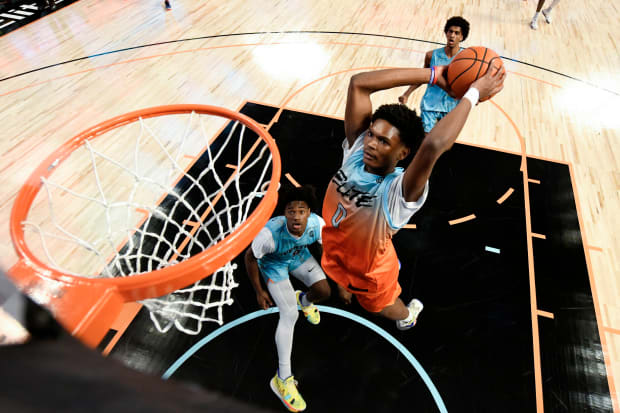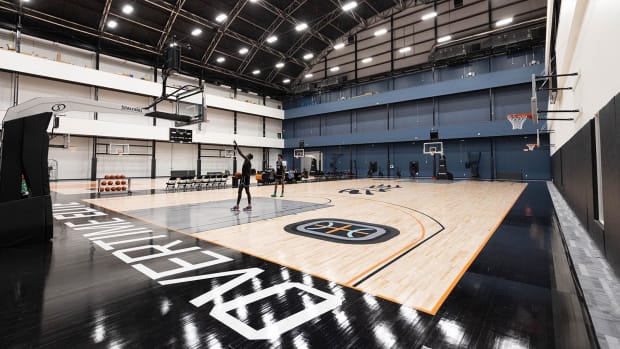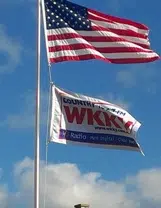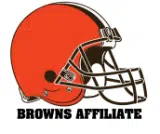OTE’s pro day in Atlanta highlighted several potential NBA prospects.
ATLANTA — Only once in the history of the NBA draft have we seen the first four players selected hail from somewhere outside of the college basketball industrial complex. Despite the influx of international talent and alternative pathways to the league, it doesn’t happen often. The year was 2001, and those four players were Kwame Brown, Tyson Chandler, Pau Gasol and Eddy Curry, in that order—three American high schoolers and a budding international star from Spain, all bigs.
It is presently 2022 and this is very much October, so it goes without saying that nothing is certain in the context of the forthcoming draft, but there’s a possibility—perhaps not a strong one, but one that’s reasonable enough to discuss right now—that the 2023 class might mirror that elusive feat. Victor Wembanyama and Scoot Henderson sit as the consensus top two early-season prospects, inbound from France’s Pro A and the G League Ignite program, respectively. Meanwhile, more than 70 scouts descended on Atlanta this week to check in on Amen and Ausar Thompson, twin prospects who could feasibly round out the draft’s top four eight months from now.
The Thompson twins are signed with Overtime Elite, which has expanded ahead of its second year as an alternative pathway for teenage players, some of whom are preparing for professional careers, and others who are maintaining college eligibility. That option is a new offering from OTE, which worked with the NCAA to ensure that its next wave of prep players would have that option and prove its own academic viability. The on- and off-court resources available to players are of the highest quality, and while actual development into NBA-caliber prospects isn’t guaranteed, there are obvious growth opportunities for those that put the time in.

Courtesy of Overtime Elite
The Thompsons—who, not for nothing, are described as OTE’s most fervent gym-dwellers—signed up for the maiden voyage last season, intending to use the program as a two-year springboard into the draft. As evidenced by the strong attendance in Atlanta this week for OTE’s pro day, that plan remains on track: the Thompsons are projected lottery picks on pretty much every preseason mock draft, for as much as that’s worth. (Amen was No. 4 and Ausar No. 6 on SI’s offseason Big Board.) So, the scouts showed up.
“In a game setting, I don’t even notice [scouts] in the crowd,” Amen told Sports Illustrated. “But in a workout setting … I still enjoy it, but you get a little bit more anxious.
“No clapping. Nobody’s going Yay,” he added, chuckling. “You feel all the eyes.”
If you’re wondering—What even is a pro day?—they can be most efficiently described as glorified practices that feature drills and competitive intra-squad play, where a program formally invites all 30 NBA teams to come watch their players work out. The concept was popularized by John Calipari’s Kentucky teams to help strengthen the notion that their program was a pro player factory. Many high major college programs now hold them, which often leads to eye-rolls from NBA scouts as they travel to gyms where, alas, there may not actually be any future pros on the floor. OTE’s pro day was efficient in that respect, with the Thompsons as headliners, but also a handful of other prospects on the court, some of them draft-eligible and others a year or two away.
As someone with a professional opinion on this matter, I’m not always convinced pro days are all that important, at least as far as who made shots or who scored how many points is concerned. But seeing players get reps in and studying them up close can always spawn some useful takeaways. And what was exceptionally clear is how much more advanced both Thompsons are relative to their current peer group. The twins will turn 20 in January, meaning they’re older than a lot of the competition they’ll face this season and that they’re the same age or older than many players in the current NBA rookie class. With that notion seemingly in mind, OTE sent the Thompsons on a rigorous summer tour that included games against pro teams in Spain, Serbia, the TBT, and a recent exhibition against Australia’s Adelaide 36ers in Phoenix. The twins held their own, but teams will still to nitpick that element of the whole deal.
Still, from a talent perspective, there simply aren’t many players in this year’s potential draft class who can match the Thompsons’ mixture of athleticism, focus and ability to impact the floor on both ends, especially in transition. It’s always fair to ask questions about what skills translate, particularly when players are preparing for a massive step up in level, not to mention when that level is the NBA. But if it needed stating, there’s little doubt among scouts right now that they are legitimate lottery-level prospects.
“God has sprinkled some magical dust on them to be 6' 7″ and jumping out the gym like that,” says Kevin Ollie, OTE’s head of coaching and basketball development, who also coached UConn to the 2014 national title and played 13 NBA seasons. “But also, you got to make sure you enhance your gift too—by working—and they just continue to work.”
The challenge with twins, particularly those who are teammates, is finding ways to accurately separate them from each other, a task NBA teams will spend the season solving. After all, one of them has to get drafted before the other. The challenge is a bit more difficult considering that Amen and Ausar will play for the same team on OTE’s circuit this season, after spending last year on different ones. But as is often the case with twin brothers who have spent much of their lives playing on the same team, their skill sets are complementary. As the twins explain it, Ausar was the more aggressive shooter and scorer growing up, which led to his brother bringing the ball up more and created some slight positional distinction between the two.
The general consensus right now is that Amen is the slightly higher-upside prospect, due largely to his demonstrated acumen as a jumbo point guard. He is an exceptional passer, plays with pace and effectively attacks open space, and puts pressure on the rim as a driver. His size and speed getting to spots often help cover for the fact that his jumper remains a work in progress, as he can still get downhill when defenders sag off. I was encouraged by the improved mechanical consistency he showed on his shot Tuesday, and the hope is that it will begin to better translate into game settings this season. Amen is also an exceptional defender who covers a ton of ground with his stride, quickness and instincts in pursuit of the ball.
Ausar spends more time playing on the wing, but is also quite capable with the ball in his hands, consistently showing impressive passing flashes in the opportunities he’s given. He’ll need to tighten his handle to play on-ball with increased volume. I personally wonder if his optimal development path includes a shift into an on-ball playmaking role, which, similarly to his brother, may slightly lower the bar for how far his jumper has to progress for him to be a difference-maker. He also has a ways to go in that department as far as repping out more consistent mechanics, but for what it’s worth, he’s reputed as the guy who always drags everyone else into the gym. If his shot doesn’t come around, it won’t be for any lack of effort. He is a slightly more physical defender than his brother and is more frequently lauded for his work on that end.
Because both Thompsons are remarkable athletes—and their respective strengths stem from such similar gifts—discerning them in a forward-thinking sense can feel a bit figurative. In other words: scouts can see what their current strengths and weaknesses are and how they fit together, but their skillset, bodies and traits are still alike enough that the twins could conceivably wind up in similar roles when, presumably, they join different NBA franchises come June. It’s a bit perplexing to think about, but again, one of them has to get picked first.
There’s quite a bit of work left for both Thompsons to sniff stardom in the pros. But the fact that each brings quite a bit to the table from an intangibles perspective should help assuage concerns that either could fail entirely if their jumpers and handles don’t catch up to their other skills. The combination of elite athleticism and quality mental makeup creates an appealing theoretical floor here. But, of course, the hope is that the twins excel beyond that. Lottery teams will have to think hard about it.
“I tell all of our guys all the time, it’s only about 12 to 15 stars and superstars [in the NBA],” says Damien Wilkins, general manager and head of basketball at OTE and a 10-year NBA veteran. “Everyone else is role playing. Everyone else is someone that stars in their role. So you come here, you know, we’re not promising that you’re gonna play in the NBA or that you’re going to play professional basketball, but we do promise that you’re going to be prepared for it. … I just think we continue to be as transparent as possible. And sometimes that truth stings a little bit, but at the end of the day, I know they’ll appreciate it down the road.”
On that note, let’s wrap with four longer-term OTE prospects to keep an eye on moving forward.

Dustin Chambers/USA TODAY
Izan Almansa, F
Height: 6' 10″ | Weight: 220 | Draft-eligible: 2024
It was a bit of a surprise twist that Almansa made arguably the biggest summer leap of any Overtime Elite prospect, winning MVP of FIBA’s Under-17 World Cup and Under-18 European Championship while playing for his native Spain. He joined OTE from Real Madrid’s academy, so there was always pedigree on his side, but his game appears to have taken off from a confidence standpoint, and NBA teams are keeping tabs on his continued growth. Almansa has gotten stronger and quicker over the past year. He has a good amount of skill for a big forward, with a 7’ 1” wingspan and advanced coordination and scoring instincts inside 15 feet. He fits many of the criteria for a modern four-man, particularly if he’s able to consistently extend his shooting range, and appears to be on an excellent trajectory at the moment.
Tyler Smith, F
Height: 6' 9″ | Weight: 210 | Draft-eligible: 2024
Smith has the shooting potential and movement skills to eventually fit in as a stretch big at the NBA level, wielding a 7’ 1” wingspan and solid jumper mechanics that make him a person of interest for pro teams. While his actual shooting splits haven’t quite caught up yet—he shot just 24% from three and 65% from the line with OTE last season—Smith has a projectable frame and a lot of untapped physical potential if he continues to add strength and improve his overall conditioning. He’s not all that vertically explosive, which places a big premium on his skill development and understanding of his own role moving forward. Smith is still a year away from the draft, and it may take him some time to put everything together, but he’s someone who scouts should take seriously and whose development warrants close monitoring over the next 18 months.
Bryson Tiller, F
Height: 6' 9″ | Weight: 220 | Draft-eligible: 2026
I began tracking Tiller over the summer on the UnderArmour Circuit and Elite 24 game and feel pretty optimistic about his long-term future. As a rising sophomore, the 16-year-old Tiller is one of the youngest players at OTE and is maintaining his future NCAA eligibility through the process, but he’s also technically old enough to reclassify, forgo college and enter the 2025 draft. He’s not an elite vertical athlete, but he’s coordinated and skilled with the ball. And he has perimeter functionality as a combo forward, coupled with a 7’ 2” wingspan. Tiller has excellent instincts and his strengths in the midrange and on the interior have translated across all the settings I’ve seen so far. If he gains physical strength, extends his shooting range and unlocks more of his athletic ability through training, I’d expect his profile to rise. Tiller fits the mold of a modern forward, and while there’s a long way to go before we worry about him in a draft context, I’m curious to see whether he takes a leap in OTE’s program.
Bryson Warren, G
Height: 6' 2″ | Weight: 175 | Draft-eligible: 2024
Warren continues to stand out to me as one of Overtime Elite’s better long-term prospects, with an NBA-type body (he’s listed with a 6’ 5” wingspan) and steady composure for a lead guard still at a very early stage of his development. While Warren’s assist numbers didn’t pop off the page last season, his decision-making skills are promising and he’s a pretty reliable shot-maker for his age, although he’ll have to continue smoothing out a noticeable hitch in his release. There’s also plenty of room for Warren to gradually add more muscle to his frame. He’ll need to make big strides in terms of efficiency and playmaking over the next 18 months, but if everything breaks in a good direction here, we should be talking about him as a potential draft pick in 2024.
More NBA Coverage:














